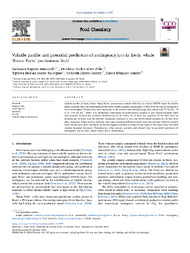Volatile profile and potential predictors of astringency loss in fresh, whole ‘Rama Forte ’ persimmon fruit.
Volatile profile and potential predictors of astringency loss in fresh, whole ‘Rama Forte ’ persimmon fruit.
Author(s): ANTONIOLLI, L. R.; ALVES FILHO, E. G.; RODRIGUES, T. H. S.; GARRUTI, D. dos S.; CANUTO, K. M.
Summary: Volatile profile of fresh, whole ‘Rama Forte’ persimmons treated with CO2 or ethanol (EtOH) vapor for astringency removal, and the relationship of the main volatile organic compounds (VOCs) with the loss of astringency were investigated. Persimmons were harvested at the commercial maturity stage and treated with 70 % CO2, 18 h, or 1.70 mL kg?1 EtOH, 6 h. Headspace solid-phase microextraction coupled to gas chromatography–mass spectrometry allowed the tentative identification of 34 VOCs, 15 of them are reported for the first time on persimmons. Ethanol was the relevant compound common to CO2 and EtOH-treated samples in the first days after treatment, while acetoin, hexanal, and trans-2-hexenal ((E)-hex-2-enal) were the relevant VOCs in samples from the last days after treatment. As the astringency reached its lowest levels, some of the main VOCs had their relative intensity increased. Pentadecanal, ethyl acetate, acetoin, and ethanol may be potential predictors of astringency loss in fresh, whole ‘Rama Forte’ persimmons.
Publication year: 2025
Types of publication: Journal article
Unit: Embrapa Grape & Wine
Observation
Some of Embrapa's publications are published as ePub files. To read them, use or download one of the following free software options to your computer or mobile device. Android: Google Play Books; IOS: iBooks; Windows and Linux: Calibre.
Access other publications
Access the Agricultural Research Database (BDPA) to consult Embrapa's full library collection and records.
Visit Embrapa Bookstore to purchase books and other publications sold by Embrapa.

